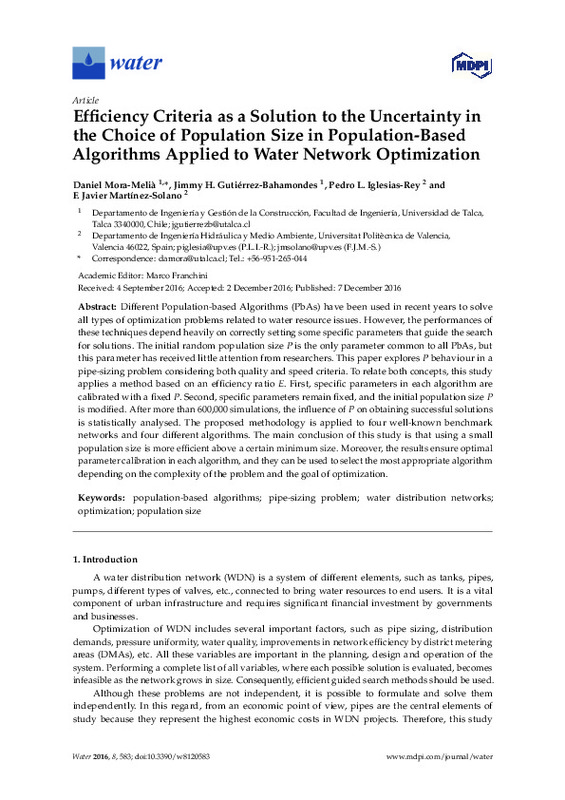JavaScript is disabled for your browser. Some features of this site may not work without it.
Buscar en RiuNet
Listar
Mi cuenta
Estadísticas
Ayuda RiuNet
Admin. UPV
Efficiency Criteria as a Solution to the Uncertainty in the Choice of Population Size in Population-Based Algorithms Applied to Water Network Optimization
Mostrar el registro sencillo del ítem
Ficheros en el ítem
| dc.contributor.author | Mora Meliá, Daniel
|
es_ES |
| dc.contributor.author | Gutiérrez Bahamondes, Jimmy H.
|
es_ES |
| dc.contributor.author | Iglesias Rey, Pedro Luis
|
es_ES |
| dc.contributor.author | Martínez-Solano, F. Javier
|
es_ES |
| dc.date.accessioned | 2017-09-28T12:23:59Z | |
| dc.date.available | 2017-09-28T12:23:59Z | |
| dc.date.issued | 2016-12 | |
| dc.identifier.issn | 2073-4441 | |
| dc.identifier.uri | http://hdl.handle.net/10251/88188 | |
| dc.description.abstract | [EN] Different Population-based Algorithms (PbAs) have been used in recent years to solve all types of optimization problems related to water resource issues. However, the performances of these techniques depend heavily on correctly setting some specific parameters that guide the search for solutions. The initial random population size P is the only parameter common to all PbAs, but this parameter has received little attention from researchers. This paper explores P behaviour in a pipe-sizing problem considering both quality and speed criteria. To relate both concepts, this study applies a method based on an efficiency ratio E. First, specific parameters in each algorithm are calibrated with a fixed P. Second, specific parameters remain fixed, and the initial population size P is modified. After more than 600,000 simulations, the influence of P on obtaining successful solutions is statistically analysed. The proposed methodology is applied to four well-known benchmark networks and four different algorithms. The main conclusion of this study is that using a small population size is more efficient above a certain minimum size. Moreover, the results ensure optimal parameter calibration in each algorithm, and they can be used to select the most appropriate algorithm depending on the complexity of the problem and the goal of optimization. | es_ES |
| dc.description.sponsorship | This study was supported by the Program Initiation into research (Project 11140128) of the Comision Nacional de Investigacion Cientifica y Tecnologica (Conicyt), Chile. | en_EN |
| dc.language | Inglés | es_ES |
| dc.publisher | MDPI | es_ES |
| dc.relation.ispartof | Water | es_ES |
| dc.rights | Reconocimiento (by) | es_ES |
| dc.subject | Population-based algorithms | es_ES |
| dc.subject | Pipe-sizing problem | es_ES |
| dc.subject | Water distribution networks | es_ES |
| dc.subject | Optimization | es_ES |
| dc.subject | Population size | es_ES |
| dc.subject.classification | MECANICA DE FLUIDOS | es_ES |
| dc.title | Efficiency Criteria as a Solution to the Uncertainty in the Choice of Population Size in Population-Based Algorithms Applied to Water Network Optimization | es_ES |
| dc.type | Artículo | es_ES |
| dc.identifier.doi | 10.3390/w8120583 | |
| dc.relation.projectID | info:eu-repo/grantAgreement/CONICYT//11140128/ | es_ES |
| dc.rights.accessRights | Abierto | es_ES |
| dc.contributor.affiliation | Universitat Politècnica de València. Escuela Técnica Superior de Ingenieros Industriales - Escola Tècnica Superior d'Enginyers Industrials | es_ES |
| dc.contributor.affiliation | Universitat Politècnica de València. Departamento de Ingeniería Hidráulica y Medio Ambiente - Departament d'Enginyeria Hidràulica i Medi Ambient | es_ES |
| dc.description.bibliographicCitation | Mora Meliá, D.; Gutiérrez Bahamondes, JH.; Iglesias Rey, PL.; Martínez-Solano, FJ. (2016). Efficiency Criteria as a Solution to the Uncertainty in the Choice of Population Size in Population-Based Algorithms Applied to Water Network Optimization. Water. 2016(8). https://doi.org/10.3390/w8120583 | es_ES |
| dc.description.accrualMethod | S | es_ES |
| dc.relation.publisherversion | http://doi.org/10.3390/w8120583 | es_ES |
| dc.description.upvformatpinicio | 583 | es_ES |
| dc.type.version | info:eu-repo/semantics/publishedVersion | es_ES |
| dc.description.volume | 2016 | es_ES |
| dc.description.issue | 8 | es_ES |
| dc.relation.senia | 325587 | es_ES |
| dc.contributor.funder | Comisión Nacional de Investigación Científica y Tecnológica, Chile | es_ES |








